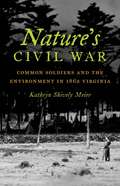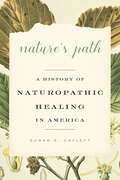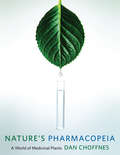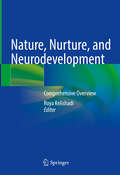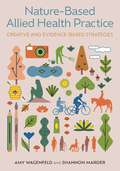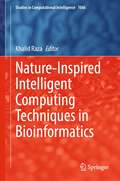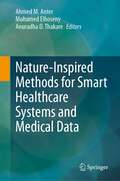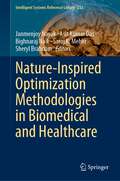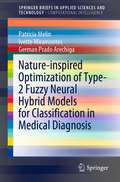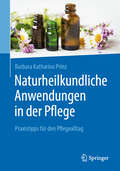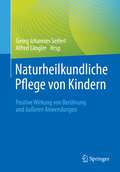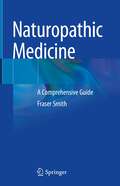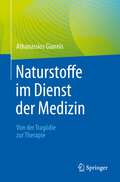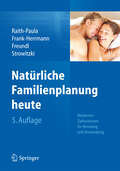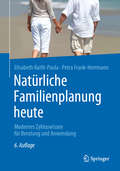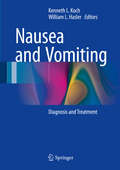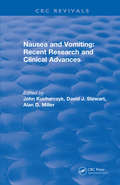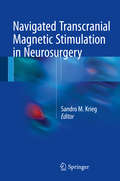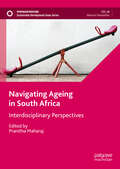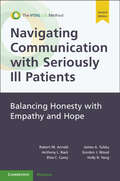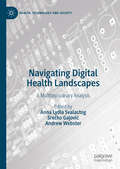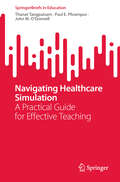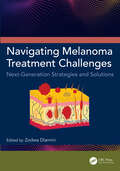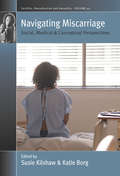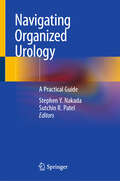- Table View
- List View
Nature's Civil War
by Kathryn Shively MeierIn the Shenandoah Valley and Peninsula Campaigns of 1862, Union and Confederate soldiers faced unfamiliar and harsh environmental conditions--strange terrain, tainted water, swarms of flies and mosquitoes, interminable rain and snow storms, and oppressive heat--which contributed to escalating disease and diminished morale. Using soldiers' letters, diaries, and memoirs, plus a wealth of additional personal accounts, medical sources, newspapers, and government documents, Kathryn Shively Meier reveals how these soldiers strove to maintain their physical and mental health by combating their deadliest enemy--nature.Meier explores how soldiers forged informal networks of health care based on prewar civilian experience and adopted a universal set of self-care habits, including boiling water, altering camp terrain, eradicating insects, supplementing their diets with fruits and vegetables, constructing protective shelters, and most controversially, straggling. In order to improve their health, soldiers periodically had to adjust their ideas of manliness, class values, and race to the circumstances at hand. While self-care often proved superior to relying upon the inchoate military medical infrastructure, commanders chastised soldiers for testing army discipline, ultimately redrawing the boundaries of informal health care.
Nature's Path: A History of Naturopathic Healing in America
by Susan E. CayleffAn eclectic group of firebrands overcame strong odds to create the naturopathic healing system.An alternative medical system emphasizing prevention through healthy living, positive mind-body-spirit strength, and therapeutics to enhance the body’s innate healing processes, naturopathy has gained legitimacy in recent years. In Nature’s Path—the first comprehensive book to examine the complex history and culture of American naturopathy—Susan E. Cayleff tells the fascinating story of the movement’s nineteenth-century roots.While early naturopaths were sometimes divided by infighting, they all believed in the healing properties of water, nutrition, exercise, the sun, and clean, fresh air. Their political activism was vital to their professional formation: they loathed the invasive, depletive practices of traditional medicine and protested against medical procedures that addressed symptoms rather than disease causes while resisting processed foods, pharmaceuticals, environmental toxins, and atomic energy. Cayleff describes the development of naturopathy’s philosophies and therapeutics and details the efforts of its proponents to institutionalize the field. She recognizes notable naturopathic leaders, explores why women doctors, organizers, teachers, and authors played such a strong role in the movement, and identifies countercultural views—such as antivivisection, antivaccination, and vegetarianism—held by idealistic naturopaths from 1896 to the present.Nature’s Path tracks a radical cultural critique, medical system, and way of life that links body, soul, mind, and daily purpose. It is a must-read for historians of medicine and scholars in women’s studies and political history, as well as for naturopaths and all readers interested in alternative medicine.
Nature's Pharmacopeia: A World of Medicinal Plants
by Dan ChoffnesThis beautifully illustrated, elegantly written textbook pairs the best research on the biochemical properties and physiological effects of medicinal plants with a fascinating history of their use throughout human civilization, revealing the influence of nature's pharmacopeia on art, war, conquest, and law. By chronicling the ways in which humans have cultivated plant species, extracted their active chemical ingredients, and investigated their effects on the body over time, Nature's Pharmacopeia also builds an unparalleled portrait of these special herbs as they transitioned from wild flora and botanical curiosities to commodities and potent drugs. The book opens with an overview of the use of medicinal plants in the traditional practices and indigenous belief systems of people in the Americas, Africa, Asia, and ancient Europe. It then connects medicinal plants to the growth of scientific medicine in the West. Subsequent chapters cover the regulation of drugs; the use of powerful plant chemicals—such as cocaine, nicotine, and caffeine—in various medical settings; and the application of biomedicine's intellectual frameworks to the manufacture of novel drugs from ancient treatments. Geared toward nonspecialists, this text fosters a deep appreciation of the complex chemistry and cultural resonance of herbal medicine, while suggesting how we may further tap the vast repositories of the world's herbal knowledge to create new pharmaceuticals.
Nature, Nurture, and Neurodevelopment: Comprehensive Overview
by Roya KelishadiFrom the birth, children grow and learn in response to the stimulation from their social and physical environment. Research on early brain development provides a great opportunity to examine how nature and nurture work together to shape human development. Through the use of sophisticated technology, scientists have discovered how early brain development and nurturing care interact to create a foundation for future growth and learning. New evidence supports the effect of nature-nurture interactions on childhood development primarily through advances in longitudinal studies. Neural processes, influenced by genetic and epigenetic variation, and other underlying factors including environment, infection, inflammation, hormonal and immune functions, etc., have critical roles in brain development. The term "nurturing care" was described as a core component for achieving optimal development in the early years of life, when the brain is developing and the child is more responsive to interventions. Recent evidence has revealed that parenting interventions that include components to enhance child learning or strengthen parent-child relationships are effective for improving early cognitive, language, motor, and socioemotional development. This book aims: (1) to describe various domains of neurodevelopment in children; (2) to report the estimates of children at risk of not achieving their developmental potential; (3) to present a life course conceptual framework of early childhood development; (4) to review new aspects of neurodevelopment in children; eg., neurobiology, neuroimmunology; (5) to describe the risk factors affecting early brain development; (6) to report the neurodevelopment screening tools in children; (7) to assess the role of nurturing care in early brain development; and (8) to describe programs and policies implemented for early childhood development and their effectiveness for improving development in childhood.
Nature-Based Allied Health Practice: Creative and Evidence-Based Strategies
by Amy Wagenfeld Shannon MarderThe benefits of interacting with nature for our social, cognitive, and physical wellbeing are well documented. But how practical is it to take therapy into nature, or bring nature into therapy?This evidence-based and accessible guide demonstrates easily workable, creative, tried-and-tested strategies for bringing nature into therapy. It includes simple and fun ready-to-go activity ideas. Using the life-course as a framework, the authors highlight the impact of nature at every stage of human development. From younger children to older adults, anyone can benefit from outdoor therapy, and different therapeutic offerings can be adapted to suit most individuals and groups. Resources are included to help assess a program's readiness to incorporate nature, create plans to take therapy outdoors (or bring the outside in), and evaluate the impact it could have for patients or clients.With testimonials from service users who have felt the benefits of nature-based practices, and case studies highlighting excellence in practice from health and social care professionals across various fields, this book will inspire and empower allied health and mental health practitioners to take their therapy practice outdoors.
Nature-Inspired Intelligent Computing Techniques in Bioinformatics (Studies in Computational Intelligence #1066)
by Khalid RazaThis book encapsulates and occupies recent advances and state-of-the-art applications of nature-inspired computing (NIC) techniques in the field of bioinformatics and computational biology, which would aid medical sciences in various clinical applications. This edited volume covers fundamental applications, scope, and future perspectives of NIC techniques in bioinformatics including genomic profiling, gene expression data classification, DNA computation, systems and network biology, solving personalized therapy complications, antimicrobial resistance in bacterial pathogens, and computer-aided drug design, discovery, and therapeutics. It also covers the role of NIC techniques in various diseases and disorders, including cancer detection and diagnosis, breast cancer, lung disorder detection, disease biomarkers, and potential therapeutics identifications.
Nature-Inspired Methods for Smart Healthcare Systems and Medical Data
by Mohamed Elhoseny Ahmed M. Anter Anuradha D. ThakareThis book aims to gather high-quality research papers on developing theories, frameworks, architectures, and algorithms for solving complex challenges in smart healthcare applications for real industry use. It explores the recent theoretical and practical applications of metaheuristics and optimization in various smart healthcare contexts. The book also discusses the capability of optimization techniques to obtain optimal parameters in ML and DL technologies. It provides an open platform for academics and engineers to share their unique ideas and investigate the potential convergence of existing systems and advanced metaheuristic algorithms. The book's outcome will enable decision-makers and practitioners to select suitable optimization approaches for scheduling patients in crowded environments with minimized human errors.The healthcare system aims to improve the lives of disabled, elderly, sick individuals, and children. IoT-based systems simplify decision-making and task automation, offering an automated foundation. Nature-inspired metaheuristics and mining algorithms are crucial for healthcare applications, reducing costs, increasing efficiency, enabling accurate data analysis, and enhancing patient care. Metaheuristics improve algorithm performance and address challenges in data mining and ML, making them essential in healthcare research. Real-time IoT-based healthcare systems can be modeled using an IoT-based metaheuristic approach to generate optimal solutions.Metaheuristics are powerful technologies for optimization problems in healthcare systems. They balance exact methods, which guarantee optimal solutions but require significant computational resources, with fast but low-quality greedy methods. Metaheuristic algorithms find better solutions while minimizing computational time. The scientific community is increasingly interested in metaheuristics, incorporating techniques from AI, operations research, and soft computing. New metaheuristics offer efficient ways to address optimization problems and tackle unsolved challenges. They can be parameterized to control performance and adjust the trade-off between solution quality and resource utilization. Metaheuristics manage the trade-off between performance and solution quality, making them highly applicable to real-time applications with pragmatic objectives.
Nature-Inspired Optimization Methodologies in Biomedical and Healthcare (Intelligent Systems Reference Library #233)
by Sheryl Brahnam Janmenjoy Nayak Bighnaraj Naik Asit Kumar Das Saroj K. MeherThis book introduces a variety of well-proven and newly developed nature-inspired optimization algorithms solving a wide range of real-life biomedical and healthcare problems. Few solo and hybrid approaches are demonstrated in a lucid manner for the effective integration and finding solution for a large-scale complex healthcare problem. In the present bigdata-based computing scenario, nature-inspired optimization techniques present adaptive mechanisms that permit the understanding of complex data and altering environments. This book is a voluminous collection for the confront faced by the healthcare institutions and hospitals for practical analysis, storage, and data analysis. It explores the distinct nature-inspired optimization-based approaches that are able to handle more accurate outcomes for the current biomedical and healthcare problems. In addition to providing a state-of-the-art and advanced intelligent methods, it also enlightens an insight for solving diversified healthcare problems such as cancer and diabetes.
Nature-inspired Optimization of Type-2 Fuzzy Neural Hybrid Models for Classification in Medical Diagnosis (SpringerBriefs in Applied Sciences and Technology)
by Patricia Melin Ivette Miramontes German Prado ArechigaThis book describes the utilization of different soft computing techniques and their optimization for providing an accurate and efficient medical diagnosis. The proposed method provides a precise and timely diagnosis of the risk that a person has to develop a particular disease, but it can be adaptable to provide the diagnosis of different diseases. This book reflects the experimentation that was carried out, based on the different optimizations using bio-inspired algorithms (such as bird swarm algorithm, flower pollination algorithms, and others). In particular, the optimizations were carried out to design the fuzzy classifiers of the nocturnal blood pressure profile and heart rate level. In addition, to obtain the architecture that provides the best result, the neurons and the number of neurons per layers of the artificial neural networks used in the model are optimized. Furthermore, different tests were carried out with the complete optimized model. Another work that is presented in this book is the dynamic parameter adaptation of the bird swarm algorithm using fuzzy inference systems, with the aim of improving its performance. For this, different experiments are carried out, where mathematical functions and a monolithic neural network are optimized to compare the results obtained with the original algorithm. The book will be of interest for graduate students of engineering and medicine, as well as researchers and professors aiming at proposing and developing new intelligent models for medical diagnosis. In addition, it also will be of interest for people working on metaheuristic algorithms and their applications on medicine.
Naturheilkundliche Anwendungen in der Pflege: Praxistipps für den Pflegealltag
by Barbara K. PrinzViele naturheilkundliche Anwendungen können in Rahmen der Pflege präventiv und gesundheitsfördernd wirken. Wärme- oder Kälteanwendungen stimulieren dabei vor allem den Stoffwechsel, das Immun- oder das Herz-Kreislaufsystem, andere Maßnahmen, z. B. die Aromatherapie aktivieren und fördern die Selbstheilungskräfte und steigern das Wohlbefinden. Das Buch beschreibt unterschiedliche naturheilkundliche Pflegemethoden und Anwendungen, wie etwa von traditionellen Wickeln und Auflagen, erweitert durch die Aromapflege und rhythmischen Einreibungen bis hin zum neuen Konzept der Patientenedukation.Es werden Qualitätsmerkmale und Qualitätssicherung, die Umsetzung im Pflegeprozess erläutert, sowie der Anspruch an einer naturheilkundlichen Pflegekompetenz herausgearbeitet. Zudem werden naturheilkundliche Maßnahmen bei häufigen Indikationen im Pflegebereich vorgestellt.Das Buch richtet sich an stationäre oder ambulante Pflegefachkräfte, aber auch Patienten, Angehörige oder Interessierte werden darin viele wertvolle Anregungen erhalten.
Naturheilkundliche Pflege von Kindern: Positive Wirkung von Berührung und äußeren Anwendungen
by Alfred Längler Georg Johannes SeifertJeder braucht Berührungen um gesund zu bleiben!Dieses Buch richtet sich an Pflegende und zeigt die positive Wirkung von Berührungen und äußeren Anwendungen bei Kindern. Berührungsbasierte Pflege hat einen essentiellen Einfluss auf die körperliche, psychische und emotionale Gesundheit des Menschen. Besonders Kinder brauchen diese Form der Zuwendung und Nähe. Den Zusammenhang zwischen Berührung und Bindung, Wärme, Zeit und Rhythmus in Ihrer Wirksamkeit stellen die erfahrenen Autoren dieses Buches verständlich dar.Stilvolle Zeichnungen zeigen, wie die wirkungsvollen Techniken in der Praxis durchgeführt werden können. Die wohltuende Entfaltung wird dabei anhand von Symptomen analysiert.Lernen Sie, wie Sie Ihre kleinen Patienten kompetent und ganzheitlich pflegen und setzen Sie Berührungen gezielt positiv ein.
Naturopathic Medicine: A Comprehensive Guide
by Fraser SmithThis book offers comprehensive coverage of naturopathic medicine. The principles and values of this profession are already clearly stated (i.e., Find and Treat the Cause; Treat the Whole Person, etc.), but few are the textbooks that provide a clear exposition of what the approach is that differs from what is described as conventional or allopathic medicine. The toolkit – herbs or nutrients – then becomes the defining feature, but this is not the most important attribute. To paraphrase the historian of medicine Harris Coulter – in this approach the body reacts creatively to stressors – and the Empirical school or natural medicine approach is more focused on supporting adaptive responses than suppressing symptoms. Or to put it another way, naturopathic physicians certainly do things to ameliorate symptoms, but their real interest is to discern what disturbances to the determining factors of health lead to imbalances, physiological dysfunction, and are generating the symptoms. This is not an attempt to argue that all health issues can get better on their own or that conventional medical interventions aren’t capable of producing stellar outcomes. Conventional medicine holds great value, but there remains a concurrent need for a naturopathic approach that helps rebuild the body.There is a need for an approach in medicine that works to support adaptive responses of the body, reduce maladaptive responses, address determining factors of health, and sometimes create temporary homeostasis with agents such as drugs (or certain natural medicines) can play to maintain life when the body’s healing responses are insufficient. This book takes this approach and begins by examining what health is and then what states lead to disease. In terms of the basis of disease states, the book teaches about how the lack of coordination in the body’s bioregulatory systems (hormones, nervous system, cell signaling) can lead to disease, as well as the impact of irreversible degeneration, genetic damage, chronic stress, etc. The book takes the reader to some of the more common and well described reasons for these states of dysfunction, including the body’s inability to process environmental toxins and disruptions to the human microbiome. The book then teaches how to assess a patient, and how various natural therapies impact root causes of disease, the long term consequences, and the various clinical manifestations.The book then takes a systems approach – cardiovascular, pulmonary, etc. This is where most books on the subject start, but instead of breaking out a number of conditions and giving protocols of diet, supplements, herbs etc., the author examines how to restore stability and function to that system. There is in depth coverage of how to confront degenerative processes that make self-healing far more challenging, or perhaps not entirely attainable. The application of the model of healing outlined in previous chapters is applied to each system. Special topics are then covered, ranging from lifespan/primary care considerations to the role of research, the rise of advanced data analytics as decision assistance, to the environmental, cultural, and global determinants of health. Each chapter will additionally include tables that summarize key diagnosis or treatment points, arrayed in an order that reflects the model presented in the book.This is an ideal guide for students in naturopathic medicine, as well as physicians and medical professionals looking to learn more about this field aimed towards maximizing patient resilience.
Naturstoffe im Dienst der Medizin - Von der Tragödie zur Therapie
by Athanassios GiannisWir leben im goldenen Zeitalter der Medizin und die Patienten profitieren von einer Vielzahl wertvoller Medikamente, die als Therapeutika bei diversen Erkrankungen erfolgreich eingesetzt werden: Sie erhöhen sowohl die Lebenserwartung als auch die Lebensqualität und ermöglichen schmerzlose operative Eingriffe. Die überwiegende Anzahl dieser Medikamente stammt direkt oder indirekt aus der Natur. So wurde ein indianisches Pfeilgift gezähmt und in ein Mittel verwandelt, das die Chirurgie revolutioniert hat. Ein Gift aus West-Afrika heilt gelähmte Patienten, während der Inhaltstoff aus den Kokablättern die Lokalanästhesie überhaupt ermöglichte. Sein künstlich hergestellter Nachfolger Lidocain nimmt die Angst vor dem Zahnarztbesuch. Aus verdorbenem Klee wurde ein Mittel isoliert, das noch heute als Blutverdünner angewendet wird. Ein Stoff aus den Wurzeln des Apfelbaumes entwickelt sich zu einem wichtigen Mittel gegen Diabetes und ist dabei, Bereiche der Kardiologie grundlegend zu verändern. Aus Südamerika und aus China kommen die zwei wichtigsten Mittel gegen Malaria, die als Patriarch der Krankheiten bezeichnet wird. Schließlich wird die Geschichte eines künstlich hergestellten Giftes erzählt, das einen Paradigmenwechsel in der Therapie einiger Krebsformen darstellt. Insgesamt handelt es sich hier um 11 Kapitel mit jeweils einer Krankheit, die kurz mit einer Geschichte beschrieben wird. Historische Hintergründe werden diskutiert und die Personen und Charaktereigenschaften werden kurz beleuchtet. Das Buch enthält auch Fotos von Personen, Pflanzen, Dokumenten. Es ist eine Odyssee mit Stationen in Medizin, Biologie, Chemie, Pharmakologie, Botanik, Mythologie, Archäologie.
Natürliche Familienplanung heute
by Thomas Strowitzki Elisabeth Raith-Paula Günter Freundl Petra Frank-Herrmann Ursula SottongNatürliche Familienplanung (NFP) - das sind gesundheitlich unbedenkliche Methoden zur sicheren Empfängnisverhütung und zur gezielten Schwangerschaftsplanung. Auf Basis der neuesten internationalen Literatur bietet der Standardleitfaden umfassende Informationen und viele Anwendungsbeispiele zur NFP. Diskutiert werden auch die Möglichkeiten moderner Medien für die Zyklusüberwachung und -auswertung wie z. B. Softwareprogramme. Der Leitfaden eignet sich zur Vorbereitung und Begleitung von Beratungsgesprächen und als Nachschlagewerk für Anwenderinnen.
Natürliche Familienplanung heute: Modernes Zykluswissen für Beratung und Anwendung
by Elisabeth Raith-Paula Petra Frank-HerrmannNatürliche Familienplanung (NFP) – das sind gesundheitlich unbedenkliche Methoden zur sicheren Empfängnisverhütung und zur gezielten Schwangerschaftsplanung. Auf Basis der neuesten internationalen Literatur bietet der Standardleitfaden umfassende Informationen und viele Anwendungsbeispiele zur NFP. Diskutiert werden auch die Möglichkeiten moderner Medien für die Zyklusüberwachung und -auswertung wie z. B. Softwareprogramme. Der Leitfaden eignet sich zur Vorbereitung und Begleitung von Beratungsgesprächen und als Nachschlagewerk für Anwenderinnen.
Nausea and Vomiting
by Kenneth L. Koch William L. HaslerThis volume provides a comprehensive and state-of-the-art text for health care professionals who are interested in the diagnosis and treatment of nausea and vomiting. Because the majority of causes of nausea and vomiting arise from disorders of the gastrointestinal system, the text emphasizes the GI system by organ from esophagus to colon. It also reviews how disorders of the abdominal wall, the endocrine system, and autonomic and central nervous systems can contribute to nausea and vomiting syndromes that can be difficult to diagnose. Various treatment modalities are presented and organized in terms of drug treatments, electrical stimulation devices, and dietary therapy and nutritional support. Furthermore, the book is enhanced by chapters on the pathophysiology of nausea, the pathophysiology of vomiting, the physiological changes in the brain during nausea and vomiting, and the psychological underpinnings of nausea and vomiting. And because many children are afflicted with unexplained nausea and vomiting, a chapter devoted to pediatric patients is also included. Written by authorities in the field, Nausea and Vomiting: Diagnosis and Treatment is a valuable resource that will help practitioners and healthcare providers consider specific diagnoses in treating the noxious and burdensome symptoms of nausea and vomiting.
Nausea and Vomiting: Recent Research And Clinical Advances (CRC Press Revivals)
by John Kucharczyk David J Stewart Alan D MillerThis volume combines incisive state-of-the-art research regarding nausea and vomiting with articles summarizing current medical knowledge of clinical problems associated with these symptoms. Topics include the historical perspective on research on nausea and emesis, clinical assessments of current and proposed anti-emetic drug therapy, and motion sickness and space sickness. The book features over 30 tables and 6 figures to help simplify the information presented. Nausea and Vomiting: Recent Research and Clinical Advances will interest all scientists who conduct research on how the brain and gastrointestinal system interact in the control of emesis. It will also contain valuable information for clinicians, researchers involved in anti-emetic drug development, and pharmaceutical companies.
Navigated Transcranial Magnetic Stimulation in Neurosurgery
by Sandro M. KriegThis book is the first comprehensive work summarizing the advances that have been made in the neurosurgical use of navigated transcranial magnetic stimulation (nTMS) over the past ten years. Having increasingly gained acceptance as a presurgical mapping modality in neurosurgery, today it is widely used for preoperative mapping of cortical motor and language function, risk stratification and improving the accuracy of subcortical fiber bundle visualization. This unique work will provide neurosurgeons and neuroscientists who are starting their nTMS program essential and detailed information on the technique and protocols, as well as the current clinical evidence on and limitations of the various applications of nTMS. At the same time, more experienced nTMS users looking for deeper insights into nTMS mapping and treatment in neurosurgery will find clearly structured, accessible information. The book was prepared by an international mix of authors, each of which was chosen for their status as a respected expert on the respective subtopic, as evinced by their landmark publications on nTMS.
Navigating Ageing in South Africa: Interdisciplinary Perspectives (Sustainable Development Goals Series)
by Pranitha MaharajThis book systematically explores the lives and varied experiences of older people in South Africa. Though a relatively youthful country, the share of the population aged sixty and above in South Africa is increasing steadily and is projected to reach 10% of the population by 2025. Population ageing is having major and far-reaching implications for a country with widespread poverty, changing household structures, a heavy burden of communicable diseases, and inadequate health infrastructure. Pandemics, such as HIV/AIDS and COVID-19, exacerbate many of the challenges faced by older people. Drawing on original research from national surveys and case studies, this book explores the various experiences and challenges of older people in their daily lives, such as their healthcare, social and family lives, their socio-economic status, mental health, and what it means to be an older person in South Africa today.
Navigating Communication with Seriously Ill Patients: Balancing Honesty with Empathy and Hope
by Robert M. Arnold Anthony L. Back Elise C. Carey James A. Tulsky Gordon J. Wood Holly B. YangWhen clinicians communicate effectively, patients retain more information, have higher trust and a better quality of life. Such a patient-centred approach is the future of clinical care, and this book is an essential how-to guide on improving these skills. Grounded in innovative and evidence-based methodology, perfected through over twenty years of teaching in the VitalTalk training program, content includes foundational communication skills, how to help patients plan for the future, what to do when you are really stuck, and strategies to work through conflicts with colleagues. In this updated edition, emphasis is placed on the roles privilege, race, and power play in the medical encounter, and new tools are provided to help clinicians navigate this landscape with greater self-awareness and sensitivity. This practical guide is filled with skills and roadmaps, demonstrating how to be clearer when sharing information, more competent at understanding patient concerns, and more effective when making recommendations.
Navigating Digital Health Landscapes: A Multidisciplinary Analysis (Health, Technology and Society)
by Andrew Webster Anna Lydia Svalastog Srećko GajovićNavigating Digital Health Landscapes explores how users navigate the internet when searching for health information. It is the first book to conceptualise the internet as a landscape and the ways in which people navigate this digital world, including the complex entanglements between on and offline domains. It does so through a range of disciplinary perspectives from expert contributors across STS (science and technology studies), social anthropology, biomedicine, ethics and law, linguistics, social policy and computer scientists working in more technical aspects of tracking and visualising data and information on the internet. The book provides a unique and valuable contribution for those wishing to understand how digital technologies are affecting the design, implementation and use of digital systems to manage health information in different contexts.
Navigating Healthcare Simulation: A Practical Guide for Effective Teaching (SpringerBriefs in Education)
by John M. O'Donnell Thanat Tangpaisarn Paul E. PhrampusThis book is crafted for both novice simulation educators embarking on their teaching careers and seasoned subject matter experts seeking to enhance the effectiveness of their simulation programs. The book draws on the effort of a novice simulation educator under the guidance of two simulation experts with over 40 years of collective experience. Readers will embark on a transformative journey with this book, which is designed to empower readers who utilize simulation as a teaching tool. This book serves as a roadmap, leading educators toward a more organized and practical approach to conducting simulations. Covering a wide spectrum of topics, the book begins with insights into associated learning theories for simulation, providing valuable strategies for increasing learner engagement. Delving deeper, it explores various simulation modalities and locations, guiding educators to choose the best options for their teaching objectives. Within the pages of this handbook, readers will find detailed discussions on scenario design, simulation phases and crucial aspect of simulation best practices including prebriefing, implementation, facilitation and debriefing among others. In addition, the book addresses learner assessment and course evaluation, ensuring a well-rounded understanding of the entire simulation process. The authors invite readers to explore the wealth of knowledge within these pages, with the hope that they will gain valuable insights to elevate their simulation knowledge and skills and contribute to the continuous improvement of their teaching practices to the benefits of their students.
Navigating Melanoma Treatment Challenges: Next-Generation Strategies and Solutions
by Zodwa DlaminiThis book delves into the complexities of melanoma, offering an in-depth examination of the disease alongside the latest advancements in diagnosis and treatment. The initial chapter provides a comprehensive overview of melanoma, covering its fundamentals and introducing the latest technologies shaping the understanding of the disease. The book introduces advanced molecular diagnostics in identifying targetable mutations and tailoring therapies for personalized and effective melanoma treatment. Additionally, it investigates the role of artificial intelligence in melanoma diagnostics and the advancements in imaging technologies for the monitoring and assessment of melanoma. It also reviews novel, innovative immunotherapeutic approaches designed to enhance the body's immune response against melanoma cells. Further, the book delves into the development and application of targeted therapies and nanomedicine in treating melanoma. A dedicated chapter highlights the advantages of a multi-omics approach, integrating genomic, proteomic, and other omics data to achieve a holistic understanding of melanoma. Toward the end, the book examines the potential of combination therapies to improve treatment outcomes in melanoma. The book is a valuable source for cancer researchers, medical oncologists, and clinicians. Key Features Provides a comprehensive overview of melanoma, covering its fundamentals and introducing the latest diagnostics and treatment strategies. Investigates the transformative impact of artificial intelligence in melanoma diagnostics. Focuses on immunotherapeutic advancements against melanoma. Investigates the advancements in targeted therapies and nanomedicine. Explores the synergy of genomics and proteomics in a comprehensive multi-omics approach to melanoma treatment.
Navigating Miscarriage: Social, Medical and Conceptual Perspectives (Fertility, Reproduction and Sexuality: Social and Cultural Perspectives #45)
by Susie Kilshaw Katie BorgMiscarriage is a significant women's health issue. Research has consistently shown that one in four pregnancies end in miscarriage. This collected volume explores miscarriage in diverse historical and cultural settings with contributions from anthropologists, historians and medical professionals. Contributors use rich ethnographic and historical material to discuss how pregnancy loss is managed and negotiated in a range of societies. The book considers meanings attached to miscarriage and how religious, cultural, medical and legal forces impact the way miscarriage is experienced and perceived.
Navigating Organized Urology: A Practical Guide
by Stephen Y. Nakada Sutchin R. PatelThis book discusses the management of various aspects of the professional life of newly qualified urologists as well as more experienced urologists. It features clear, easy-to-read chapters covering various topics, including clinical and surgical patient care, administrative duties, and research despite the increasing constraints on time and resources in today's hectic practice environment. Navigating Organized Urology: A Practical Guide systematically presents a range of practical strategies for a successful transition from trainee to practising urologist, while also offering more experienced urologists a fresh perspective on efficient management and successful adaptation of their practices for the modern age.
